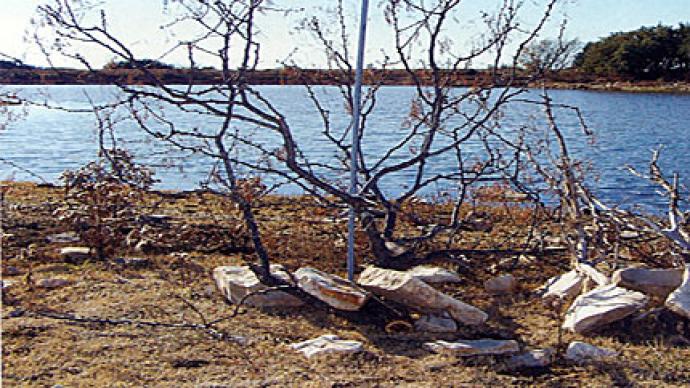For the thinking pond owner, it's not enough merely to recognize a challenge. A successful holistic approach to pond and fish management requires not only an ability to assess problems, but also to select and understand the tools for effective solutions.
In our previous installment, we discussed the importance of aeration and some options available when implementing an aerator. Equally important in our approach is AquaMats. These devices, placed on the bottom of a sportfish pond or other reservoir, may provide what nearly every water body lacks.
We think AquaMats may be just what you have been looking for, even when you were not actually looking. Fishermen and pond managers already know the importance of habitat to fish. For forage fish, underwater habitat offers protection from predators. Habitat gives fish a place to congregate, which appears to reduce stress levels in fish, making them less vulnerable to disease, healthier and more prolific on the spawning bed.
For predator fish such as largemouth or trout, habitat is equally beneficial. Ever wonder why big bass like to lurk around fallen trees and under rock outcroppings? There are two things nearly every animal needs - food and shelter. They position themselves in areas where food is prevalent and try to ensure that they themselves don't become lunch.
Installing habitat and fish attractors is a lesson in Food Chain Management 101: Give the little fish a safe place to hang out and reproduce, and all those little fish (AKA lunch) will attract the big fish (AKA your lunch).
Artificial habitat comes in all shapes and sizes. Christmas trees, old tires, concrete cinder blocks, just about anything you can imagine is used to provide habitat. There is even a government program that dumps old tanks and airplanes into the Gulf of Mexico for fish habitat.
Open any pond supply catalog, and you'll be sure to find a handful of man-made fish attractors. Manmade habitats are particularly advantageous because they are made of plastics, which do not leach like metals or bio-degrade like Christmas trees, which requires annual re-installation, not to mention adding to your pond's nutrient load. They are easier to install than concrete and other bulky materials, and unlike aquatic plants, do not tend to grow out of control.
Although manmade products can be more expensive ($30-$200) than "lying around" surplus materials (cinder block, PVC pipe, bricks), customers who use them soon discover the advantages are well worth the extra expense.
Here's where AquaMats come in: Like traditional manmade habitats, AquaMats provide ideal spawning and protection areas for fish and other animals, but they also have the ability to add natural biofiltration to their list of benefits. This makes AquaMats and similar products the next generation in aquatic habitat.
Just as plants and trees serve to filter the air we breathe, microscopic plants and bacteria have the same filtration ability in water. This community of tiny living organisms is collectively referred to as periphyton.
Periphyton is the bright green, fuzzy stuff you'll often see growing on submerged rocks in streams, or in the bottom of your pond. AquaMats provide surface area engineered to make a home for periphyton. Lots of it. The more surface area you have, the more periphyton you may grow. The more periphyton you grow, the cleaner your water becomes.
How much area do AquaMats provide? A single unit (2 feet x 2 feet x 3 feet) has roughly the same surface area as a tennis court.
Given this extra room to grow, the community clinging to the AquaMats not only filters the water but supports the bottom of the food chain for fish. Fish and plants die and become nutrients, and AquaMats grow the periphyton that can cycle these nutrients into food. How? Little insects eat periphyton... Which get eaten by little fish... And the little fish get eaten by big fish.
As a result, the bottom-dwelling mats provide a holistic approach to management. They enhance the average pond's ability to recycle nutrients, just like a natural ecosystem, enabling the pond to control and overcome the natural "problems" that may occur. You might be asking, if the system is "natural," why do I need to add AquaMats?
Most ponds, owing to surface runoff from rain and other factors, have more incoming nutrients than the normal amount of periphyton can process. By offering expanded amounts of surface area, AquaMats allow the natural community to populate a pond as such an elevated level, they can keep up with the incoming nutrients that might otherwise cause trouble. Better yet, the mats indirectly convert the nutrient problem into food for your fish.
So, in a holistic approach to management, rather dealing with symptoms of typical pond problems - algae blooms and fish kills - managers are able to remedy the problem at the source. One caution: Do not place AquaMats in your pond and expect all your challenges to disappear. These mats are a tool, and a tool is only as useful as the hands using it.
Properly used, however, AquaMats provide pond owners and managers a tool that can manage nutrients and improve fish survival and growth-rates, while offering grass-like habitat for fish that will not grow out of control. All told, the mats may increase pond productivity without sacrificing clear water. Try getting all those benefits from a discarded Christmas tree.
Reprinted with permission from Pond Boss Magazine



